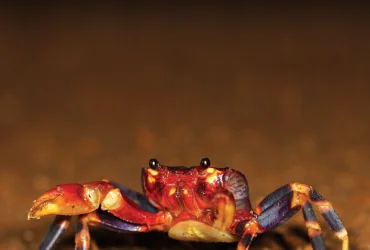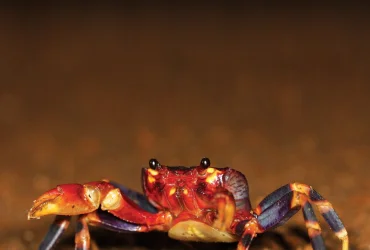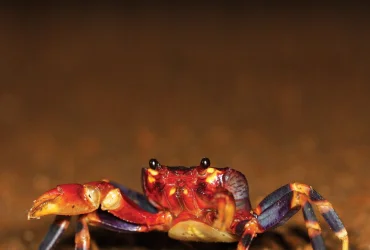Volume 7 | Number 1 | May 2015
 v7i1.151
v7i1.151ISSN: 1800-427X (print)
eISSN: 1800-427X (online)
DOI:10.47605/tapro.v7i1.151
Submitted date: 12 May 2014
Accepted date: 30 November 2014
Published date: 19 January 2015
Pp. 20–28, Pl. 12–14.
SPATIAL DISTRIBUTION AND HABITAT CORRELATES OF NILGIRI WOOD-PIGEON (Columba elphinstonii) IN NORTH WESTERN GHATS, INDIA
Pankaj Koparde, Monali Mhaskar, Prachi Mhaske & Ankur Patwardhan
*Corresponding author. E-mail: pankajkoparde@gmail.com
Abstract
Nilgiri wood-pigeon (Columba elphinstonii) was surveyed in two forest types (open and closed) for spatial distribution and habitat correlates using belt transects across 94 localities in Sahyadri Tiger Reserve, India, during 2011–2013. Only closed forested localities showed presence of the species with maximum number of individuals sighted in evergreen forests. Poisson multiple regression analysis was conducted on species abundance data from 18 sites and seven variables. The species was found to be associated with high canopy cover and evergreen forests. Suitable habitat of the species was predicted using MaxEnt model. MaxEnt model showed high degree of suitable habitat in west Chandoli National Park and the corridor area of the tiger reserve. This paper provides fine scale distribution data and habitat correlates and discusses potential threats to the species in north Western Ghats and stresses the immediate need for conservation action in this area.
Key words : avifauna, biogeography, conservation, distribution, ecology, endemic, habitat, threatened
Section Editor: Varadharajan Gokula
eISSN: 1800-427X (online)
DOI:10.47605/tapro.v7i1.151
Submitted date: 12 May 2014
Accepted date: 30 November 2014
Published date: 19 January 2015
Pp. 20–28, Pl. 12–14.
SPATIAL DISTRIBUTION AND HABITAT CORRELATES OF NILGIRI WOOD-PIGEON (Columba elphinstonii) IN NORTH WESTERN GHATS, INDIA
Pankaj Koparde, Monali Mhaskar, Prachi Mhaske & Ankur Patwardhan
*Corresponding author. E-mail: pankajkoparde@gmail.com
Abstract
Nilgiri wood-pigeon (Columba elphinstonii) was surveyed in two forest types (open and closed) for spatial distribution and habitat correlates using belt transects across 94 localities in Sahyadri Tiger Reserve, India, during 2011–2013. Only closed forested localities showed presence of the species with maximum number of individuals sighted in evergreen forests. Poisson multiple regression analysis was conducted on species abundance data from 18 sites and seven variables. The species was found to be associated with high canopy cover and evergreen forests. Suitable habitat of the species was predicted using MaxEnt model. MaxEnt model showed high degree of suitable habitat in west Chandoli National Park and the corridor area of the tiger reserve. This paper provides fine scale distribution data and habitat correlates and discusses potential threats to the species in north Western Ghats and stresses the immediate need for conservation action in this area.
Key words : avifauna, biogeography, conservation, distribution, ecology, endemic, habitat, threatened
Section Editor: Varadharajan Gokula
 v7i1.150
v7i1.150ISSN: 1800-427X (print)
eISSN: 1800-427X (online)
DOI:10.47605/tapro.v7i1.150
Submitted date: 22 February 2014
Accepted date: 30 July 2014
Published date: 19 January 2015
Pp. 14–19, Pl. 9–11.
PREYING FREQUENCY OF COMMON KINGFISHER, Alcedo atthis (LINNAEUS, 1758) IN BANGLADESH
Habibon Naher
*Corresponding author. E-mail: habibonnaher@yahoo.com
Abstract
A study on the preying frequency of common kingfisher (Alcedo atthis) was conducted from September 2008 to September 2011 at Nikunja-1 in Dhaka City Corporation Area of Bangladesh. The objective of the study was to determine the average preying frequency per day across different months using focal animal sampling method. It preyed 8.5 times / day, with the highest frequency of preying at 11:01–12:00 h and 16:01–17:00 h. The average frequency was highest in September and lowest in April and highest in monsoon season and lowest in summer. Food items comprised of arthropods (31.7%) and fish (68.3%). From May through September, they avoided arthropods preferring fish as it was peak breeding season. During this period, they were preoccupied with courtship, nest building and caring of their nestlings.
Key words : breeding season, behaviour, Dhaka City, feeding activities, monsoon, summer
Section Editor: Varadharajan Gokula
eISSN: 1800-427X (online)
DOI:10.47605/tapro.v7i1.150
Submitted date: 22 February 2014
Accepted date: 30 July 2014
Published date: 19 January 2015
Pp. 14–19, Pl. 9–11.
PREYING FREQUENCY OF COMMON KINGFISHER, Alcedo atthis (LINNAEUS, 1758) IN BANGLADESH
Habibon Naher
*Corresponding author. E-mail: habibonnaher@yahoo.com
Abstract
A study on the preying frequency of common kingfisher (Alcedo atthis) was conducted from September 2008 to September 2011 at Nikunja-1 in Dhaka City Corporation Area of Bangladesh. The objective of the study was to determine the average preying frequency per day across different months using focal animal sampling method. It preyed 8.5 times / day, with the highest frequency of preying at 11:01–12:00 h and 16:01–17:00 h. The average frequency was highest in September and lowest in April and highest in monsoon season and lowest in summer. Food items comprised of arthropods (31.7%) and fish (68.3%). From May through September, they avoided arthropods preferring fish as it was peak breeding season. During this period, they were preoccupied with courtship, nest building and caring of their nestlings.
Key words : breeding season, behaviour, Dhaka City, feeding activities, monsoon, summer
Section Editor: Varadharajan Gokula
 v7i1.149
v7i1.149ISSN: 1800-427X (print)
eISSN: 1800-427X (online)
DOI:10.47605/tapro.v7i1.149
Submitted date: 4 December 2013
Accepted date: 10 October 2014
Published date: 19 January 2015
Pp. 8–13, Pl. 4–8.
DISPLAY BEHAVIOUR OF INDIAN PEAFOWL Pavo cristatus (AVES: GALLIFORMES) DURING THE MATING SEASON IN VIRALIMALAI, TAMILNADU, INDIA
Varadharajan Gokula & V. Muthukrishnan
*Corresponding author. E-mail: gokulae@yahoo.com
Abstract
The Indian peafowl (Pavo cristatus), the largest of the pheasants in India, inhabits mostly semi-arid conditions. We examined the courtship displays of free-ranging peacocks in relation to the orientation and the relative positions of females being courted from August 2012 to January 2013 in Viralimalai, Tamil Nadu, India, to address these questions: (1) Do the peacocks orient their courtship display towards the sun? (2) Is there any relationship between the presence of peahen and the duration of display of peacock? (3) Is there any site-preference to display? We found that the majority of the displays were oriented towards the sun initially, but then oriented towards peahen (regardless of direction) soon after their arrival. Although peacock displayed even in the absence of peahen, presence of peahen influenced the display duration of peacock. Displays were performed largely in open areas.
Key words : courtship, orientation, peahen, pheasants, semi-arid habitats, South India
Section Editor: S.M. Henkanaththegedara
eISSN: 1800-427X (online)
DOI:10.47605/tapro.v7i1.149
Submitted date: 4 December 2013
Accepted date: 10 October 2014
Published date: 19 January 2015
Pp. 8–13, Pl. 4–8.
DISPLAY BEHAVIOUR OF INDIAN PEAFOWL Pavo cristatus (AVES: GALLIFORMES) DURING THE MATING SEASON IN VIRALIMALAI, TAMILNADU, INDIA
Varadharajan Gokula & V. Muthukrishnan
*Corresponding author. E-mail: gokulae@yahoo.com
Abstract
The Indian peafowl (Pavo cristatus), the largest of the pheasants in India, inhabits mostly semi-arid conditions. We examined the courtship displays of free-ranging peacocks in relation to the orientation and the relative positions of females being courted from August 2012 to January 2013 in Viralimalai, Tamil Nadu, India, to address these questions: (1) Do the peacocks orient their courtship display towards the sun? (2) Is there any relationship between the presence of peahen and the duration of display of peacock? (3) Is there any site-preference to display? We found that the majority of the displays were oriented towards the sun initially, but then oriented towards peahen (regardless of direction) soon after their arrival. Although peacock displayed even in the absence of peahen, presence of peahen influenced the display duration of peacock. Displays were performed largely in open areas.
Key words : courtship, orientation, peahen, pheasants, semi-arid habitats, South India
Section Editor: S.M. Henkanaththegedara
Hubungi Kami
The ultimate aim of the journal is to provide an effective medium for communication of the latest and best scientific information.
Copyright © 2020 Taprobanica. All Rights Reserved
Jasa Pembuatan Website by IKT




